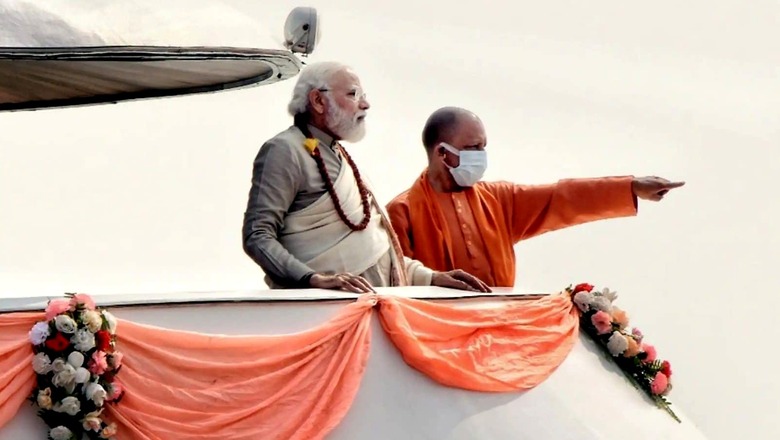
views
Realising it has gained maximum seats in central and northern India, the Bharatiya Janata Party focussed its energy on retaining and gaining ground in the eastern part of India during 2021.
The strategy has its roots in what former BJP president Amit Shah told his workers repeatedly during public gatherings as well as in private conversations that winning states is not the “pinnacle of success” unless the party claims victory in Kerala, Tamil Nadu, West Bengal and Telangana, which has been the unchartered territory for the party.
During internal briefings, it was told that the party should look for states from where any loss of seats in northern states can be compensated.
While the party successfully retained Assam, it emerged as the leading challenger to the Mamata Banerjee regime in West Bengal.
The party also displayed its adaptable character in Assam with a change of leadership by replacing the incumbent Sarbananda Sonowal with Himanta Biswa Sarma. By giving way to Sarma as the topmost leader in the crucial state of Assam, the BJP also displayed its confidence in leaders who delivered and showed that it was willing to give critical position to a leader who did not exactly have the party’s ideological background.
Assam is considered the gateway to the northeast that was till a few years ago marred by infiltration. To ensure borders on the east remained guarded, the BJP had reached out to every segment and allied strategically based on people’s sentiments.
Assam was the only state where the saffron party was incumbent and fighting to retain power, whereas West Bengal was a different story.
West Bengal has been crucial in BJP’s scheme of things in securing the porous borders and the party was able to emerge as the primary opposition to the incumbent Trinamool Congress.
While most leaders feel that the BJP could have done better, the party seemed more than happy to have improved its tally from 3 MLAs in 77 legislators in 2021.
Many BJP leaders say they believe a lot of power centres and lack of a credible face against Banerjee has tilted poll results in the favour of TMC.
How important a single seat win is for BJP and its leadership was seen in the Puducherry elections. “Who knows? We might even need that one seat for a simple majority in 2024,” said a senior party leader when asked why so much resources and attention is given to Puducherry, referring to Atal Bihari Vajpayee government losing the vote of confidence in Lok Sabha.
However, 2021 was just a prelude to 2022 in terms of how the BJP embarks on the litmus test of assembly elections in five states ahead of the game-changing 2024 Lok Sabha polls.
The way in which Prime Minister Narendra Modi is leading from the front in seeking another five years of the Yogi Adityanath government, it is amply clear that the BJP is treating the Uttar Pradesh assembly polls as the semi-final for the 2024 General Elections. The entire cabinet and top BJP leadership will be out in full force trying to ensure that the Yogi government comes to power again.
The importance of UP is the fact that it has contributed to the biggest share of the BJP’s Lok Sabha haul in the past two parliamentary elections — with 71 seats out of 80 in 2014 and 62 seats in 2019.
To Ensure Organisation Remains Active till 2024
In a recent national executive meet, BJP national president JP Nadda asked his new team to undertake three major tasks in the coming year. ‘Saksham Mandal’ to make mandals self-reliant, ‘Sakriya’ booths and ‘Panna Pramukhs’, a time-tested pooling and organising of human resource, which proved useful during previous Gujarat elections.
To ensure effective representation of the party at the both level, the BJP will have Yogi Adityanath and two of his deputies as ‘panna pramukhs’. In the Gujarat assembly polls, home minister Amit Shah was appointed the ‘panna pramukh’ of Narainpura area.
The tasks were given to the top leaders of the party at the first physical meeting of national office bearers after the Covid lockdown in New Delhi.
Activating Morchas
PM Modi had met morcha presidents at his residence and had a task cut out for each one of them, first and foremost to be not redundant like earlier and to garner support among their communities for the party.
Like the SC morcha was asked to touch base with influential members of their communities to hold programmes to showcase government’s decision benefitting them, to expose opposition and bust myths they created against the BJP. Similarly, all other morchas were also tasked to reach out to the masses.
The morcha heads have been tasked to identify booths, which have at least 100 community votes, and form teams to channelise them.
Stitching Up Alliances
BJP believes that Hinduism is unified and not divided by castes and yet it is forced to stitch alliances with influential regional parties. For example, if a regional party is dominant in one caste, then the party will look for its alternative to secure votes from that caste. Also, to show how important the regional parties are in the scheme of things, top leaders such as Nadda and Shah meet their party chiefs.
Coordination with Outfits with Same Ideological Leanings
The RSS and BJP will have a three-day coordination meeting from January 5 in Bhagyanagar (Hyderabad) where RSS and its affiliates will give feedbacks.
Read all the Latest Politics News here



















Comments
0 comment